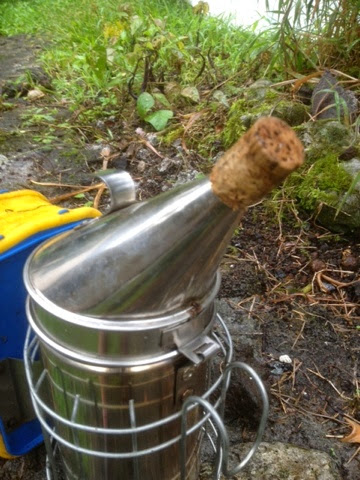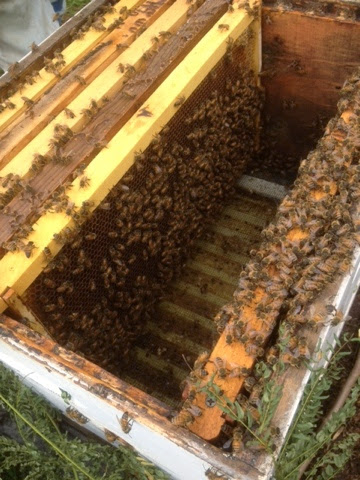Ah, thoughts of winter must be cropping up inside the heads of the mainland readers because I'm getting emails asking about winter firewood.
Where I'm now living, preparing for winter means changing the angle of the solar panels and closing the house windows at night. How simple! And boy, I surely don't miss those winter preparations that I use to do when living on the Eastcoast. It was a normal way of life back then, so I never gave it much thought. But looking back, I surely don't miss it.
Since people know that I run two woodstoves, I field lots of questions about firewood.
...Do you stockpile a winter supply?
No. Since I use firewood year around, I just store wood when there is more than I need at the moment. Stockpiling some wood has its benefits. That way I would have dry wood to get me through a rainy spell. I recall the time when we had 39 straight days of rain! Stockpiling has provided me with wood to get through an injury recovery period. Yes, I've injured myself occasionally which meant that there were a couple of weeks in a row where I couldn't gather and cut up wood.
...What tree species do you burn?
Whatever I have. Around here on the farm ohia and eucalyptus are most common. Wild guava and loquat are plentiful. But there is a variety of trees around, both natives and introduced. No oaks, maples, ash. But still nice burnable wood.
... Do you use a log splitter?
No. I don't need to have a long burning fire, such as overnight. So I don't burn big logs. It's a lot of work to hand split logs ...... I've done that in the past so I know about it all too well ......and it's not economically feasible to buy a log splitter for the homestead. Besides, logs are heavy and I'm no spring chicken anymore. Therefore I don't deal with logs for firewood. I have plenty of small stuff to use for firewood. Logs are better utilized for building low retaining walls, built up garden beds, and other projects.
... If you don't burn log wood, what do you burn?
Due to the tradewinds, I have plenty of fallen branches and twigs. Branches up to 6" diameter are always being snapped off. On top of that I have plenty of small trees that I am gradually clearing away to expand the pastures. I have the room to pile up the branches and let them sit for a year to dry out. Then I'll cut it up for firewood. Anything 1/2" diameter and larger goes for firewood. The smaller stuff goes into my biotrash piles to fill in holes on the property, or gets run through a chipper and made into mulch. Some gets set aside for kindling. Before a fresh branch goes onto the dry-out pile, I'll take a pruning shears and trim of the majority of the fresh leaves and fine twigs. They go into the garden grow boxes. No waste.
Above - This pile of small logs runs from 1 1/2" diameter up to 4" for much of the pile. One chunk is over 6" and will get used in some garden project rather than being split for firewood. This wood came from some trees I thinned out from the pastures. Besides using this wood for firewood, I tend to pick out the straight pieces for trellises and other projects.
.... Where do you buy your firewood?
That's a common question I get. I don't buy it, simple as that. There is plenty of downed wood around free for the taking. The cost of wood is my time, a saw, and something to haul it with (truck, ATV, etc). If I ever should run out of wood on my own property, there are plenty of neighbors who would love having me clear out some of their windfall debris.
...How many cords of wood do you burn in a year?
Truthfully, I can't say. Since I don't burn cord wood, I can't even compare and venture a guess. The vast majority of my firewood is stuff that other serious wood burners would pass over -- twigs, chunks, small branches. Plus I don't do long burns daily. Every second or third day the livestock cookstove gets run for 2-3 hours, cooking up a jumbo pot of assorted food stuffs. The house stove normally runs a short fire in the morning, and during the winter a brief fire at night to take the chill off.
...What tools do you use?
I do have a small 14" chainsaw, but it doesn't get a lot of use. It's brought out to cut fallen tree limbs into handable size, and for the occasional small tree to be removed. A good quality loppers gets a good workout on green stuff. I have two of those compound ones that are very easy to use. One handles up to 1 1/4" and the other can go up to 2". For anything bigger (or not green wood) than a lopper can handle, I use a sawsall (if it's standing) or a chop saw (if it's already down and carry-able). I picked up the chop saw, used, from a person who was moving. Funny to think that a chop saw is my number one firewood cutter, but it surely is easier to use than a circular saw or chainsaw.
I don't have any of the usual firewood tools that I had back on the mainland. No ax, hatchet, splitting maul, wedges, sledge hammer, chains. No rented woodsplitter. No big, serious chainsaw.
...What do you use as kindling?
Since I have plentiful twigs, I don't bother using a hatchet to chop a log into kindling. A fire gets started using newspaper, cardboard, fine twigs, 1/2" branches, then bigger stuff when it gets going. I use homemade wax/sawdust firestarters, but if I'm out of them I'll use a bit of 90% alcohol to jumpstart the fire.
Above - this pile of wind fallen twigs is my source of kindling. Small twigs for starting, larger twigs and light branches for getting things going before the 2"-4" wood is added. As needed, I will tramp on this pile then pick up the pieces and transport them in a cardboard box up to the woodstoves. Anything that won't break up by a good tramping will get cut with the chop saw.
...Do I ever use coal?
No. Coal is not naturally occurring in Hawaii. It would have to be imported. Thus I don't burn coal.
But we do have something here that burns hot somewhat like coal ----- macadamia nuts! I sometimes get several bags of old or spoiled macnuts. They burn great, but I have to use them just like I would coal. If you've ever tended a coal fire in a woodstove, you know what I mean. I'd burn macnuts all the time if I could get them for free. They make a great fire for heating and cooking.
This year I've been gathering the kukui nuts that fall in my mother's yard. I'm going to give them a try as a firewood source. They contain oil and historically were used to burn as a torch by the old Hawaiians, but I have no experience burning them myself. So we shall see. I have several 5 gallon buckets of them, so I'm ready to give them a trial run.
....Have you ever considered collecting driftwood for firewood?
Although I'm surrounded by ocean on this island, I don't see much driftwood on the beaches. And besides, there's not much beach around here. The coastline is mainly jagged rock. If there were plentiful driftwood, then I would indeed use it. But alas, there isn't enough to make a driftwood collecting trip worth while.
....Do you avoid burning certain types of wood?
If you mean tree species, well, no. We don't have much pine around here, but I would burn that too if it were plentiful. And I've burned Christmasberry with no problem, though some people claim that the smoke causes skin rashes. I haven't seen that yet. But I do avoid burning chemically treated woods such as cabinetmaking waste, exterior pressure treated construction wood, plywood, pressboard, painted wood. That sort of thing.
....How do you dispose of the ash?
Dispose isn't the word I use. Utilize. That's more like it. Wood ash goes into the garden via direct application and via the compost. Besides the ash, I also put any charcoal into the gardens too.

















































